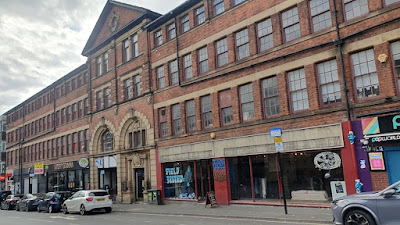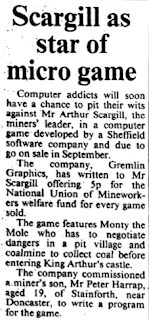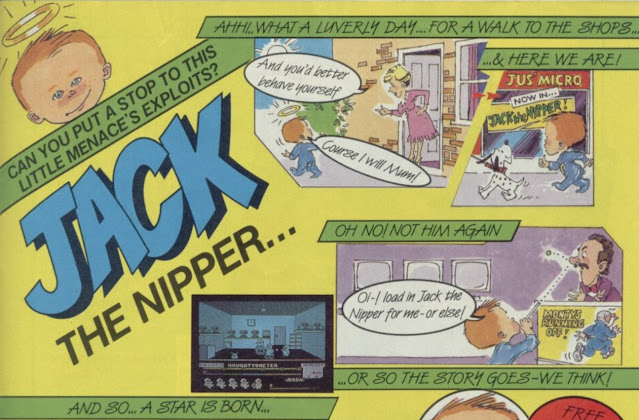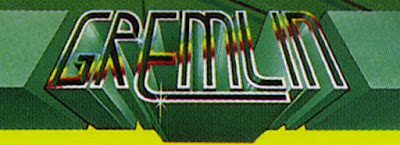Alpha House, 10 Carver Street, Sheffield, S1
It's the eve of the millennium and you fall into conversation with an 8-bit time traveller from 1985. "What happened to all the software companies?" The traveller wants to know. "What happened to Ocean?" "Gone," you tell the traveller. "Lost two years ago."
"US Gold. They must still be around."
You shake your head, "US Gold were taken over by Eidos, who were themselves formed out of Domark."
"Mirrorsoft! A company supported by Robert Maxwell's business empire must be flourishing!"
"Gone, and there's quite a story attached to that."
"Ultimate Play the Game?"
"Gone."
"Melbourne House?"
"Gone."
"I loved Highway Encounter. What happened to Vortex?"
"Gone," you sigh.
"Mastertronic?"
"Gone."
"A&F Software?"
"Gone."
"CRL?"
"Gone?"
"Hewson Consultants?"
"Gone."
"Beyond?"
"Gone."
The traveller looks frightened and lost. "Is there no one left?" They whisper.
"Oh yes," you answer, "there's Gremlin Interactive, although you'd have known them as Gremlin Graphics."
The traveller looks confused. "The Monty Mole company?"
Yes. The Monty Mole company outlasted them all. All? Not quite. Obviously there are a few exceptions. Virgin (in their Interactive Entertainment guise) outlasted Gremlin by three years. Rare is still going, as are Elite and System 3, although I'd all argue those companies exist in radically different forms to their early years. Anyway, this nuance is bad for my nice clickbait introduction. Gremlin Graphics give me the same problem as Ocean. They're well known enough that it would look odd if I missed them out but, they're also well known enough that everyone has already written about them extensively. The chance of me stumbling across anything new seems remote. Here's a list of sources I quickly assembled for this article.
1. A Gremlin in the Works by Mark Hardisty, available from Bitmap Books.
2. The Gremlin archive.
3. A RETRO GAMES MASTER interview with Gremlin Graphics founder Ian Stewart
4. A different interview with Ian Stewart from the confusingly similarly named RETRO VIDEO GAMER.
5. The Impact of Gremlin Graphics on British Video Games, a talk by Mark Hardisty with Richard Sevenson.
6. Interviews in ACE (April 1991 page 58), and CRASH (July 1985 page 28)
7. Local history memories on Sheffield Forum and Sheffield History.
8. The Story and Games of Gremlin video by Kim Justice.
This BBC News report introduced a lot of people to Gremlin Graphics on Wednesday 25th July 1984 by John Humphries, at the end of the Nine O'Clock News:
"The latest thing in computer games. It may be politically biased but it is highly topical. The villain of the piece. A miner called Arthur Scargill. The hero Monty Mole has to get his coal for the winter and run a gauntlet of flying pickets and cans of hairspray. Monty wins... using a ballot paper. The game's nineteen year old inventor is the son of a mine safety officer. He says, as far as he knows, Mr Scargill has not yet played the game."This was the first time CRASH editor Roger Kean saw Wanted: Monty Mole as he later wrote:
Quietly sitting at home one evening last summer, watching the news and with computer games far from my mind, the peace was shattered when this platform game suddenly appeared on the screen. Startled with injured surprise that some upstart new company should dare to feature a new game on telly before letting CRASH know, all I caught of the item was that it had something to do with Arthur Scargill, flying pickets and a mole. It seemed trendily topical — another cheap bunch jumping on the games bandwaggon with a ripoff idea timed to catch the miners' strike? The company's name was Gremlin Graphics. In the event CRASH wasn't missed out. We got an early Spectrum version, doctored so we would could visit any room in case none of us were able to withstand the flying pickets or the infamous crushers, and thus we were introduced to the delights of Wanted: Monty Mole, and became acquainted with Gremlin Graphics, the company that won the 1984 CRASH Readers Award for the best platform game— far from a rip-off. That was in July. Gremlin Graphics has now been going for a year and it seemed time to visit Sheffield and find out how things were going.
(July 1985 page 28).
The introduction to the feature reads "ROGER KEAN hurtles up the A68 to visit Gremlin Graphics in Sheffield". The A68 runs from Darlington to Edinburgh, so I don't know how you use that road to get from Ludlow to Sheffield. Anyway, once Roger Kean finally arrived he describes the Gremlin Graphics base as:
A gaunt Victorian office block that might once have been fashionable but now lies virtually, though tidily, empty. The Gremlins refer to it as the prison', an impression reinforced by the long, narrow corridors painted in institution maroon and cream. Gremlin Graphics has two rooms which for some obscure reason are situated high up in the building and quite some way from the ancient lift which no-one seems to use.
 |
| September 2023 |
This is where I come in. I headed to Sheffield (by train, I didn't use Roger Kean's directions) with a friend on a promise that I'd buy them lunch and not embarrass them too much as we walked around. I might have failed on the second part. I'm only really familiar with Sheffield through traumatising nuclear war drama/documentary Threads, and I may have gestured once too often at a building and exclaimed "that got nuked!" (I refrained from heading to the Tinsley Viaduct so I could stand at ground zero). Lunch was brought at the Winter Gardens which, as I later found out, also has a Threads connection. It's built on the site of the old Town Hall extension, in Threads this collapses on top of the council's civil defence team and buries them alive. [That's enough Threads chat- THE ATOMIC WEAPONS ESTABLISHMENT, ALDERMASTON].
We found Alpha House by accident. My plan was to head to West Street/Orange Street and look for the old offices of fellow Sheffield software house Alligata. We were slogging up an unremarkable road when I saw a building made familiar from Streetview, and wittily said, "oh! We're here This is one of them." Carver Street. The epicentre of Gremlin Graphics. It's the street where in 1983 Ian Stewart, and business partner Kevin Norburn, opened a shop called Just Micro. The shop was a tremendous success and lasted into the 1990s and, as shown by the local history forum links above, a lot of people have fond memories of the place. The Division Street end of Alpha House has been remodelled slightly and the shop unit which used to house Just Micro is now incorporated into the one next door. I thought it would be fun to scrape back the years and restore Just Micro using the photo printed in the July 1985 issue of CRASH and the skills of the world's worst Photoshop artist. I've got a nagging suspicion I've seen this done somewhere else but, as is traditional, I can't remember where. If I've nicked your good idea then let me know and I can at least give you a proper credit.
 |
| September 2023/ 1985 |
 |
| Percy the Potty Pigeon, Commodore 64 |
 |
| The Times, page 5 Thursday July 5 1984 |
The publicity was good for sales but bad for Gremlin. It made them stand out (in 1984 Liverpool company Thor got away with actually selling a game called Gremlins but Warner Bros. didn't notice. Thor's Gremlins was written by Chris Kerry who would go on to work for Gremlin Graphics). Warner Bros. were struggling to get Gremlins certified by the BBFC (who couldn't decide whether to rate the film PG or 15, no 12 rating in those days) and the film company would have been hypersensitive to anyone trying to muscle in on their intellectual property; plus, the rights to make a game from Gremlins had been licenced to Atari. It turns out Warner Bros. had registered a trademark on the word Gremlin since 25 October 1979 and now (presumably as a result of the royalty free licence deal) they own the rights for Gremlin's "g" logo; UK Trademark UK00002032262, entered in the trademark register on 05 July 1996 and due for renewal on 02 September 2025).
Tony Crowther quit his Gremlin directorship sometime around the end of 1984. Leaving Potty Pigeon and the less Beatrix Potter-esque Suicide Express as his two games for the company. ZZAP!64 interviewed him for the May 1985 issue, by which point he was long gone.
So you stayed with Gremlin Graphics for three or four months, was it?
Yeah, around that.
And what happened there?
Well again t didn't like the people I was working with -well, not so much I didn't like them ...it was just that... I'd never seen a company in my life, and suddenly I was in one. All right the company was doing well, but I wasn't satisfied with that, it's not the money I was after, it's a satisfying job. 1 noticed that the company was not set up correctly, it seemed as though no one knew exactly how to run the company... I don't want to go into that. I lost interest in that and didn't find I was getting what I wanted out of it.
Tony felt more comfortable talking about what happened several decades later. He explained to RETRO GAMER:
Tony had joined Gremlin on the understanding he would be an equal partner with Ian Stewart and cofounder Kevin Norburn but when Geoff Brown came on board, Tony felt his nose pushed out.
“I got cheesed off because Geoff and Ian started doing stuff without asking me,” he explains. “A chap in development called Roger Taylor said, ‘You don’t want to put up with that,’ and persuaded me to join him and set up Wizard Developments. I’d own 50% of the company which sounded better than the 25% I had at Gremlin!
(16 April 2020)
Geoff Brown was the founder of Birmingham based software distributer CentreSoft and their spin-off label US Gold. Ian Stewart knew Geoff because CentreSoft supplied Just Micro. Geoff Brown ended up owning 75% of Gremlin Graphics as he explained to Roger Kean and Chris Wilkings in THE STORY OF US GOLD:
‘I wasn’t really a business guru or sharp in any way, but Ian Stewart needed some money and it was suggested to me that what I should do is up the share capital, buy the shares, and if Ian hasn’t got the money I could take over the company. So I came to own 75% of Gremlin Graphics, although indirectly through another company I had called Woodward Brown Holdings.’
(THE STORY OF US GOLD page 65)
THE STORY OF US GOLD continues on to detail another, slightly more soap opera-ish link between Gremlin and CentreSoft:
The connection between Birmingham and Sheffield was CentreSoft’s head of sales and first employee, Jenny Richards, who was romantically involved with Ian Stewart.
(page 66)
This development disgruntled US Gold head Tim Chaney (and later the UK head of Virgin Interactive Entertainment):
He can look back and laugh at it now. ‘I love Ian, he’s a bubbly, lovely, lovely man, but back then we were bitter enemies because you had Geoff owning US Gold and me as his guy there; Geoff owning Gremlin and Ian as his guy there.
...
So was it a case of simple professional jealousy? ‘Basically, if I could have put Gremlin out of business I would have done. If I could have trampled on Ian, I would have done, or anyone else sticking their head up in the way of our business.’ He laughs at his own past feelings. ‘It was a strange relationship. You had Jenny Richards in CentreSoft, the most powerful person under Anne [Brown, co-founder CentreSoft/US Gold and Geoff's wife], going out with Ian Stewart… Jenny, Ian and Geoff quite close.’
(THE STORY OF US GOLD page 66)
One oddity of Gremlin's early days is the non-appearance of a game called Beaver Bob in Dam Trouble. CRASH first mentioned the game in October 1984 with a competition to design a loading screen for the game.
 |
| CRASH October 1984 page 90 |
The two page spread featured some bucolic Oliver Frey art, gave a brief description on the game, and filled in some useful background information about Gremlin; Tony Crowther gets a brief mention, Geoff Brown is described as "Gremlin's Managing Director", Ian Stewart "looks after the sales and marketing angles" and Kevin Norburn "signs the cheques". Beaver Bob is advertised from February to July 1985 and gets a couple of colour photographs in Roger Kean's CRASH profile.
 |
| CRASH July 1985 page 33 |
Then the game just disappears. The Gremlin archive has picture of a Beaver Bob badge and notes: "The game must have been close to completion for Gremlin to produce marketing material such as the badge." Beaver Bob was written by another boy wonder programmer, Christian Urquhart, who joined Gremlin from Ocean. By November 1985 CRASH was reporting that Christian had left to found his own company, Alphabatim, With Beaver Bob cancelled his only released game for the company was the Amstrad conversion of Rocco. Profanation and Rocco were a pair of games Gremlin swiped from under the noses of rival software house Silversoft. Spanish company Dinamic had been negotiating a UK licence with Silversoft for four games but at the last moment Gremlin slipped in and got the rights for the two best games of the four. Gremlin were a picker up of unconsidered trifles. Micromania, an Epsom based software company, declared bankruptcy in 1985 following the release of Project Future and Gremlin ended up with the rights to convert and release this game on the Amstrad. Gremlin also worked with Vortex and released the C64 version of Highway Encounter, and acted as publisher for the final two Vortex games Deflektor, 1987, and H.A.T.E: Hostile All Terrain Encounter, 1988. Also in 1988, Gremlin stepped in and grabbed the IPC licenced Roy of the Rovers after Macmillan Publishing closed their label Piranha.
The money and publicity from Wanted Monty Mole laid the foundation for the 8-bit success of Gremlin Graphics and what followed was an impressive collection of games for the Commodore 64, C16, and Spectrum. In 1985 the company was registered with Companies House. Twice. From 17 May to 18 October the record for company number 01805165 shows them trading as Gremlin Graphics Softwear before someone noticed and got the record changed to Gremlin Graphics Software, a name which lasted from 18 October 1985 to 07 September 1994.
This was the original Gremlin Graphics logo, featuring a mischievous sprite. It was replaced by this slab.
Obviously rather than provide a full and through accounting of Gremlin Graphics post 1985 I'm going to get distracted by trivia and spend ages trying to work out when the logo changed. I'm pretty sure Monty On The Run was the last time the original Gremlin Graphics logo, with gremlin, was used on an advert and that campaign was over by around January 1986. The new slab logo begins to appear from February 1986 but the little gremlin isn't gone yet. He's still running around the page on adverts for Bounder but the box art uses the old logo (ZZAP!64, March 1986) as does The Way of the Tiger. The next Gremlin game is Jack The Nipper, out around June 1986, with the new slab logo on the box and advert, and the advert still includes the running gremlin. There's a cross over period for the two styles in July 1986 when CRASH features the advert for Bounder on page 57 and Jack The Nipper on page 99. The gremlin finally disappears from adverts around September 1986. Incidentally, continuing the self-referential theme, the Just Micro shop appears in Jack The Nipper the game and the advert; the advert also includes a poster for a game called Montys Running Off!
 |
ZZAP!64 |
Gremlin was founded just as the UK software industry shifted into a more professional phase. Small software companies like Vortex, who often didn't release more than one or two games a year, found it increasingly difficult to get titles into the shops. Gremlin had the scale of releases to avoid this problem. Mobygames records Gremlin as releasing twenty games in 1985. Then twenty three in 1986. Twenty nine in 1987. And so on. They also moved across from the 8-bit machines to the new 16-bit systems, which had extra costs associated with developing enhanced graphics and sound.
There's an odd story in THE GAMES MACHINE issue 20 (July 1989 page 7). Headlined "Gremlin go back to their roots" it reads:
By the time you read this, Gremlin (producers of the astounding FOFT) will have broken all official links with US Gold management, or so their boss Ian Stewart hopes. During 1988 Gremlin Graphics had a tough year. Programmers left, after complaining about the move to US Gold's base in Birmingham from their programming offices in Sheffield; profits were slashed as they failed to react quickly to the rapidly switching 8-/16-bit market. and allegiances were broken as budget producers harpooned their lucrative and loyal youth market...
[Ian] Stewart's attempt to break away will allow him total control, and hopefully take it back to the former glory that Stewart himself fashioned. Gremlin are even going so far as to move back to Sheffield there original home.
FOFT was a game called Federation of Free Traders I'll come back to that in a minute. The question I want to ask here is, did Gremlin ever leave Sheffield? I don't think so although a number of magazines were sometimes confused by the relationship between Gremlin and US Gold.
Here, in July 1985, is HOME COMPUTING WEEKLY reviewing two games from Gremlin on the same page, Dork's Dilemma and Rocko, and yet only one review is given the correct company address, the other gets US Golds address in Birmingham. Gremlin did use US Golds offices as the base for a programming team, the imaginatively named Gremlin Birmingham, but the company as a whole was still operating from Sheffield. Gremlin Birmingham was founded in 1986 to work on US Gold's home computer versions of Gauntlet. Here's ACE, February 1989, talking about how "Gremlin have just moved to plush new offices in Birmingham's Jewelry Quarter," presumably a move away from US Golds' offices at Unit 2/3 Holford Way. THE GAMES MACHINE's article seems to have taken various bits of information (Geoff Brown's relationship with Gremlin/the existence of Gremlin Birmingham/and their move to new offices) and jumbled them together. But magazines seemed to persist in getting the wrong idea about Gremlin, here's ACE as late as June 1991:
A company who have produced the most stunning reversal of fortune the software industry has ever seen, from being perceived as a puppet of US Gold to a dynamic and innovative publisher...
Maybe the key word here is "perceived". If you were in the software industry then the relationship between US Gold and Gremlin, and the influence allowed by Geoff Brown's 75% ownership, was clearly an open secret but, as someone who just brought games, I didn't know anything about it. Oh, and if I'm 100% wrong and Gremlin did move to Birmingham please let me know.
Back to FOFT, Federation of Free Traders. This was one of Gremlin's early big games for the new 16-bit computers, and another in a long line of games touted as Elite-killers. THE GAMES MACHINE took against FOFT and gave the Atari ST version a below average review (44%) in the April 1989 issue. A quarter page box out described "The one big problem with FOFT", which was basically too many enemy ships. Gremlin were clearly disappointed by this review, especially as FOFT was more warmly received elsewhere. What really seems to have got their back up was a house advert for THE GAMES MACHINE which ran in the April issue of ZZAP!64. NEW COMPUTER EXPRESS (March 25 1988 page 5) gave the details:
Gremlin sore after Newsfield “outrage”
A bitter row has broken out between software house Gremlin and magazine publisher Newsfield concerning big name game Federation of Free Traders.
Gremlin is furious at the “ridicule” FOFT has come under in an advertisement for Newsfield's The Games Machine. The ad -which appeared in TGM's sister paper Zzap - featured the FOFT logo with ‘NO’ stamped on it. Underneath appear the words Why is Gremlin's space “epic” FOFT a load of old rubbish?" Gremlin says that the fact that The Games Machine has given the game an uncomplimentary review is irrelevant. However, it takes offence at the FOFT logo being used in an advertisement. As a result Gremlin has called in its lawyers to look at the situation and has launched an astonishing attack on the magazines’ publisher.
“I cannot think of one example where а publisher has sought to discredit a product in this manner before,” said Gremlin's Richard Barclay. “Just criticism by way of a reviewer's personal opinion is acceptable, but for a publisher to announce a corporate view in this way is quite outrageous."
Barclay went on to accuse Newsfield of “blatant sensationalism’ in order to pump up “an alarming deterioration in (magazine) sales".
Newsfield though was unrepentant. “It’s nothing to do with sensationalism,” said the firm's Roger Kean. “The game is rubbish. We played it in detail and felt that it was ‘overpriced and tedious.”
 |
| ZZAP!64 April 1989 page 96 |
As is so often the case with these sort of juicy rows, you get coverage of the initial explosion of outrage and then nothing. The odd news story about Gremlin returning to its roots comes three issues after the ZZAP!64 advert. It twice goes out of its way to praise FOFT and Gremlin "producers of the astounding FOFT":
Change of opinion, or a face-saving climbdown?
Carver House, 2-4 Carver Street, Sheffield, S1
Not long after the 1990 release of the final Monty Mole game, Impossamole, Gremlin Graphics moved 170 feet to the right, to Carver House. This is still part of the same lengthy block as Alpha House but the opposite end from Just Micro.
 |
| September 2023 |
 |
| THE TIMES 18 July 1997 |
As a result of the floatation Gremlin Interactive, which began 13 years ago at the height of the miner's strike with a £1000 loan and a rented shop opposite the National Union of Mineworkers' headquarters in Sheffield, is now worth £30 million.
 |
| September 2023 |











a fascinating history, thank you
ReplyDeleteLovely articles.
ReplyDeleteThe road used from Ludlow to Sheffield was likely the A38 rather than the A68. It goes past Derby which leads to Core Design who had their roots in Gremlin too.